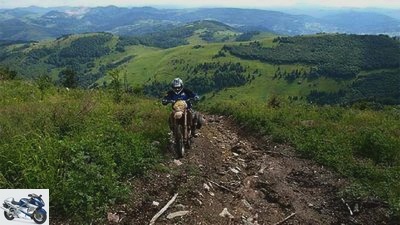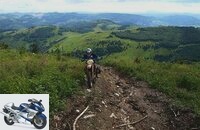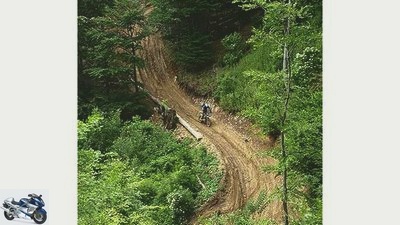Table of contents
- KTM and Husqvarna in Romania Enduro tour in the Carpathian Mountains
- Info Carpathian Mountains – Enduro tour in the Carpathian Mountains
- Info Romania – Enduro tour in the Carpathian Mountains
- Luggage on sports enduro bikes? – Enduro tour in the Carpathian Mountains

Nennewitz
to travel
KTM and Husqvarna in Romania
KTM and Husqvarna in Romania
Enduro tour in the Carpathian Mountains
What is life like in a country of the European Union where harvest workers have four hooves and the hay is still turned with a fork? A tour on secondary routes through the Romanian Carpathians provides insights.
Klaus Nennewitz
02/11/2009
Transylvanian enduro rallies brought me to Romania for the first time years ago. Captivating races, but on the way home the feeling remained of having seen a film in fast motion and not having understood anything. Brief scraps of glimpse in the mild evening sun, farmers in orchards and vegetable fields, horse-drawn carts on furrowed cart paths. This time it should be different. The bikes are the same, one KTM MXC 525 and a Husqvarna TE 450 to be able to penetrate even the most remote alpine pastures and mountains. But this time we have to cope without a supply vehicle, road book and rally bivouac, find the way on our own and drag the luggage on the barren athletes for five days and 1200 kilometers away from the road. Tom and I choose different solutions. While he is carrying everything in his backpack, I rely on a self-made luggage system at the rear of the KTM.
Buy complete article

KTM and Husqvarna in Romania
Enduro tour in the Carpathian Mountains
6 pages) as PDF
€ 2.00
Buy now
In Lugoj, our starting point, we program Sebis as the first waypoint into the GPS. A small town around 100 kilometers north of the airline. Three parallel, well-drivable dirt roads open up to us, and with joyful anticipation we dive into the new world. It’s 30 kilometers through lush meadow meadows, just right to get used to driving with luggage. Looking at the GPS display gives you an almost unreal feeling, like looking like a giant from above at mountains and valleys and placing the bikes in the right valley like toys. Unfortunately, the first move already fails: When we try to cross an 800 meter high ridge, we get stuck on a wrong track. Huge puddles, grass as high as a man and half-meter-deep lanes that already put the panniers in trouble. We climb out of the ravine and only manage to cut a swath through the surrounding thicket with the help of a hardware store folding saw. After the strenuous work, we finally get back on a mobile route at some point. Towards evening we find a lonely inn on a forest road with dangerous oncoming traffic. Still in damp enduro clothes, we pounce on dinner. There is what there is always in Romania: Ciorba, vegetables, meat and potatoes. Tastes wonderful after an exhausting enduro day. Around 10.30 p.m. the bar begins to fill up with teenage girls, and a little later the first spoiled three-seater BMWs roll up. Time to retreat to the rustic beds. The bedding doesn’t seem to have been changed especially for us – a small silk sleeping bag from the hand luggage creates the necessary distance. On the rainy morning of the second day, Cluj-Napoca becomes today’s GPS destination. We reach the crest of a mountain range on a wide sandy path that is wonderful to drive. Where we can’t resist the temptation to slip into a narrow branch. However, the path we follow through wet, tall grass is blocked by countless fallen spruce trees after a short time. Looks like a game of mikado. The two of us heave KTM and Husky one after the other over the most expansive barriers. Three hours later we are two kilometers further, completely soaked and exhausted. But the way is clear. With the last drop of gasoline we roll into the valley. The young woman at the gas station is completely surprised: Where did we come from, how would we get clean again, and whether we wouldn’t be afraid of bears and wolves in the dense forests up there? Towards evening the clouds finally tear open, and the typical Romanian picture-book landscape spreads out in front of us: green, conical mountains stand like a dune mountain in the sunset. Under the cheering of countless half-naked children from a nearby gypsy settlement, who appear out of nowhere, we work our way up the mountains on a narrow path. Before the next long stage on the following day, we first have to go down into the valley and fill up on one of the main roads. There, the new, wild capitalism almost knocks us out, overflowing the rural idyll with hectic rush and traffic chaos. In consternation, we have a coffee in the petrol station bistro while the waitress tries aggressively to peck us outside the door because of our muddy enduro boots.

Nennewitz
roads and forests, the heart of the Carpathian Mountains. It’s just stupid if they always end up in the wrong place.
A little later, when we screw our way up a cart path to 1700 meters above sea level, the shock of civilization slowly gives way. We roll 70 kilometers on a wild and romantic green plateau, the world seems to be all right again. Only a few free-living horses cross our path. Now pitch your tent here and hike for a few days. That’s it! Time takes on a new dimension. For 20 kilometers, it goes back down to the valley on a ravine similar to a bobsled run through the forest. The sky is noticeably clearing up, and we stop more and more often, soaking up the gigantic view of the deserted and completely natural landscape. At some point we reach an agricultural homestead, but the farmer opens the gate in a friendly manner and waves us through. A couple of geese and pigs dashed away, cackling and squeaking, cattle rest unimpressed, chewing on the path that crosses the property. Obviously, the relevant racing events have not yet come through here. Completely pensive, we climb up and down hills, between carpets of flowers and hay meadows, all the senses completely beguiled. The pace is steadily slowing down, the planned milestones have long ceased to be important. We let ourselves drift, float almost silently through a magical forest of young birch trees with minimal engine power. The landscape seems to glow in the last light, and like velvet paws we feel our way along the soft grass path so as not to leave any traces. An almost spiritual experience that connects Tom and I wordlessly when we watch the sunset over the alpine pastures of the Western Carpathians at the end of the day.
In the coming days we will only work our way forward using GPS and without a map. Which doesn’t always go smoothly. Often we end up on logging paths that simply end in the forest after many kilometers, cost us a lot of time and even lead to serious difficulties at one point. Already on the way back south we are suddenly standing in pouring rain on the crest of a mountain in front of the steel gate of a small barracks. Sinister-looking lumberjacks give us unmistakable signs to leave. But stupidly, the virtual track leads directly through the small pedestrian door that is still open in the large gate. No matter, better not … When trying to drive around the barracks, we come across a deeply muddy path, which, however, leads us back to the steel gate after an hour of slogging. Only this time from the other side! So we somehow got onto the barracks grounds! Panic spreads. Nobody is in sight yet, and it’s only a good 20 meters to the gate. One courageous burst of gas and we would be through – but not with panniers! When the first armed men stormed out of their barracks, there was only one solution: full throttle back. And on the wrong track the whole tedious GPS track back again. It is the only exit we know welcome to the new world of global positioning.
On the last stage, in a remote village, a police officer who has not been “updated” makes us sweat again: He keeps us at the station for half an hour and wants to see the missing visas on our ID cards. Then we can finally make him understand that Romania has been a member of the EU since 2007. A country at the other end of the timeline – it can take time to get hooked up.
Info Carpathian Mountains – Enduro tour in the Carpathian Mountains
getting there
From Munich to the Southern Carpathians there are 900 kilometers of motorway (toll). The fastest route is via Vienna, Budapest and Szeged. Then the tour begins just across the Romanian border near Timişoara. Extreme caution is advised on the last 80 kilometers of rural roads: potholes, ruthless truck drivers and loads of people and animals on the road. Thanks to EU membership, entry is unproblematic. The fuel supply
corresponds to European standards, the prices are slightly below. There are EC ATMs in larger towns, and Euros are often accepted.
equipment
Extreme restrictions are required when traveling with sports enduro bikes. We do not consider material for possible emergency overnight stays in the mountains such as tents, sleeping bags and sleeping mats to be necessary, but selected equipment. In addition to the complete enduro protective clothing, the following should be included: light rainwear, neoprene gloves and socks, first aid kit plus a simple first aid kit, a set of light “civilian clothes” including sandals and a mini toiletry kit. Put together as compact a range of tools as possible for the most necessary maintenance and repairs on the motorcycle. In addition, a repair kit, tire iron, air pump and 0.25 liters of engine oil. The main problem with sports enduro bikes is usually the range, which shouldn’t be less than 150 kilometers. The eight-liter tank of the Husqvarna occasionally had to be refilled from the 13-liter barrel of the KTM. Everything else can be bought in any larger village, which is usually never more than 50 kilometers away as the crow flies. Enduro-specific things are only available in larger cities like Sibiu (Hermannstadt).
overnight stay
In every somewhat larger village there are family guesthouses that serve a simple but good dinner from the garden at home for ten to 20 euros in addition to an overnight stay. The main course is almost always the Ciorba vegetable soup. On the arteries of the cities, modern guesthouses and small hotels offer overnight stays with meals for around 30 euros (make sure there are secure, lockable motorcycle parking spaces in the courtyard!) Those who arrive by van will often find secure parking spaces in the larger hotels.
navigation
In addition to an overview map, into which we transferred the most important refueling options from a Romanian car atlas (available at petrol stations), we only navigated with a Garmin GPS device, into which we entered the intended destination every day.
Enduro
Off-road driving is not an easy topic, even abroad. In international off-road forums, for example, there are increasing complaints about locust-like visits to southern and eastern European countries. With the consequence of constant new closures. Therefore, this report should not be an invitation to abuse Romania as a sporting playground, but to treat the country and its people with respect. The prerequisites are: It is essential to install a quiet exhaust system and avoid unnecessary noise. Take waste with you. Stay on paths and never drive over agricultural areas. Reduce the speed when meeting people and animals, especially in villages and settlements. Avoid leaving marks in the terrain by accelerating too quickly. Don’t shy away from contact with locals, stop for a short chat. An offered cigarette or some candy can break down barriers. And a friendly smile in an open helmet creates more sympathy than an aggressive full-face helmet with mirrored cross glasses.
Info Romania – Enduro tour in the Carpathian Mountains
The southern Carpathians are still unknown territory for many motorcyclists. Great enduro trails can be discovered there with caution and a sense of responsibility.
Romania
Capital: Bucharest
Area: 238 391 km2
EU member: since 2007
Currency: Leu
Population: 21,685,000
Travel time: six days
Distance covered: 1200 kilometers
Luggage on sports enduro bikes? – Enduro tour in the Carpathian Mountains
Enduro hiking is a lot of work. The van took care of the journey, but then it was time to get by on your own. The KTM was given 30 liters of luggage space
Two discarded softbags from an Aprilia Motó 6.5 formed the basis and were attached to the rear of the KTM MXC 525 with the help of a self-constructed carrier. The right one of the pockets reinforced with aluminum plates was attached to the brackets of the muffler with wing nuts and two 80 millimeter long, threaded aluminum spacers. On the left-hand side, four shaped aluminum sheets were screwed mirror-inverted to attach the exhaust to the rear of the frame. Finally, an aluminum plate attached to the rear of the frame with the seat attachment and the rear fender screw connection took up a U-tube, which leads to the bottom of the panniers and additionally stabilizes them. The measure brought a total of 30 liters of storage space.
However, the side effects of the lightweight sports enduro were considerable: when changing from deep ruts, the rear wheel only reluctantly followed and only when the machine was almost at right angles to the direction of travel. The driving experience is reminiscent of the enduros 30 years ago: very difficult to perform technical gimmicks due to the high center of gravity and at the same time unstable at speed, as the front wheel becomes too light when accelerating. Muddy driveways could be mastered completely easily because the extra weight at the rear practically pressed the tire into the earth. Another disadvantage was the limited legroom, although not as painful as with aluminum cases. Obstacles require further detours, and on narrow mountain paths the fear of getting stuck on rocky outcrops sits on your neck. The bottom line is that it is a double-edged matter that extends the range of use of a sports enduro in an appealing way, but has disadvantages in terms of driving behavior.
Related articles
-
Fisherman to travel Romania Romania In all silence It’s calm and relaxed between the Carpathian Mountains and the Black Sea coast. Dracula’s home…
-
Streblow to travel Out and about in Romania Out and about in Romania New truths Forty years after the author and his parents were on the road in Romania…
-
Traveling by motorcycle in Romania
Deleker 15th pictures Deleker 1/15 Traveling by motorcycle in Romania. Beautiful streets, villages and very friendly people make the trip an experience….
-
New forest law in Romania: No more limitless enduro fun
Rossen Gargolov counselor traffic & business New forest law in Romania: No more limitless enduro fun New forest law in Romania No more limitless enduro…
-
to travel Endurotip Romania Endurotip Romania Enduromania No driving bans, no road closures, demanding slopes – with these arguments, EnduRoMania…
-
Driving report: Husqvarna TE 449 RR rally factory machine
Jahn 22nd pictures Jahn 1/22 Factory rally machine Husqvarna TE 449 RR. Jahn 2/22 Wheels: To avoid flat tires, foam rubber rings (mousse) are always used…
-
BMW F 800 R and Husqvarna Nuda 900 – the technology behind it
Gargolov counselor technology & future BMW F 800 R and Husqvarna Nuda 900 – the technology behind it BMW F 800 R and Husqvarna Nuda 900 in a technology…
-
Husqvarna 701 models: Enduro and Supermoto with Euro 5
News 2022 New motorcycle items for 2022 Husqvarna 9 pictures Husqvarna 1/9 Husqvarna is raising the 701 models to Euro 5 level and is also donating small…
-
Husqvarna 701 Enduro-Supermoto: Additional tank kit increases range
Husqvarna 5 pictures Husqvarna 1/5 With the help of a kit, the tank of the 701 Supermoto and the 701 Enduro can be expanded to 25 liters. Husqvarna 2/5…
-
Husqvarna innovations for 2017
bmh-images 11 pictures bmh-images 1/11 Picture gallery, news: Husqvarna. bmh-images 2/11 Husqvarna Vitpilen 125: Driven by the 125cc Duke engine, the…